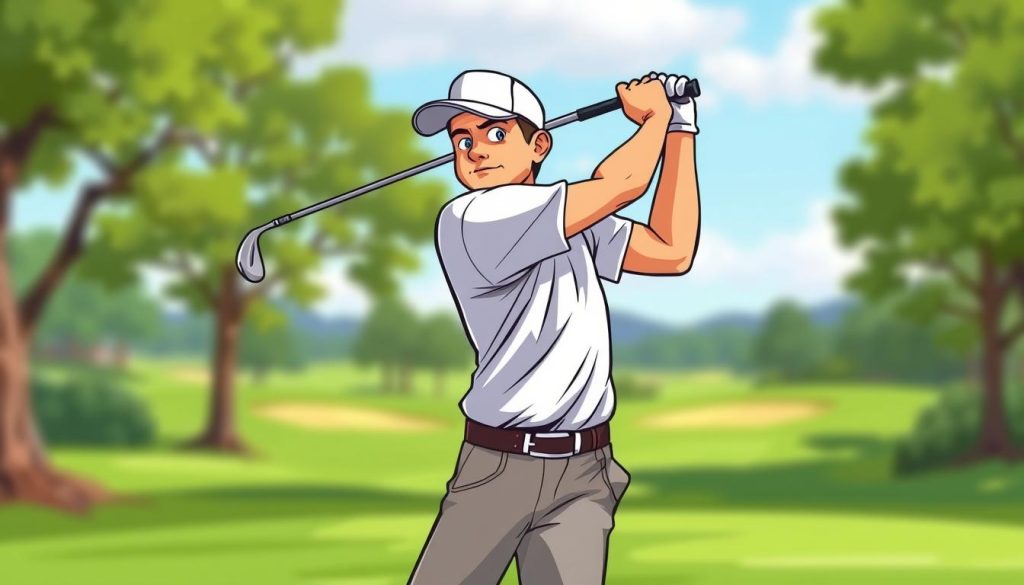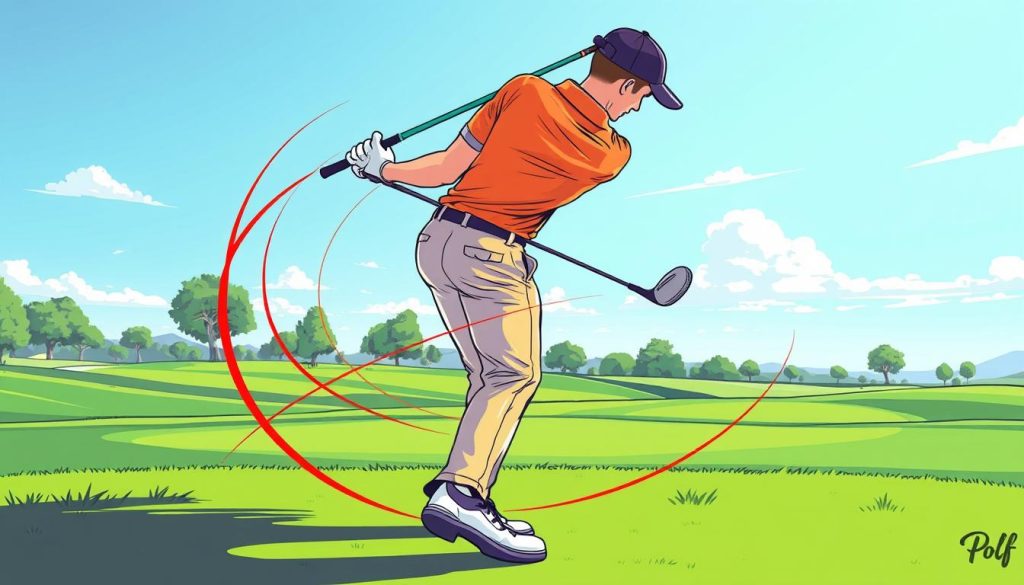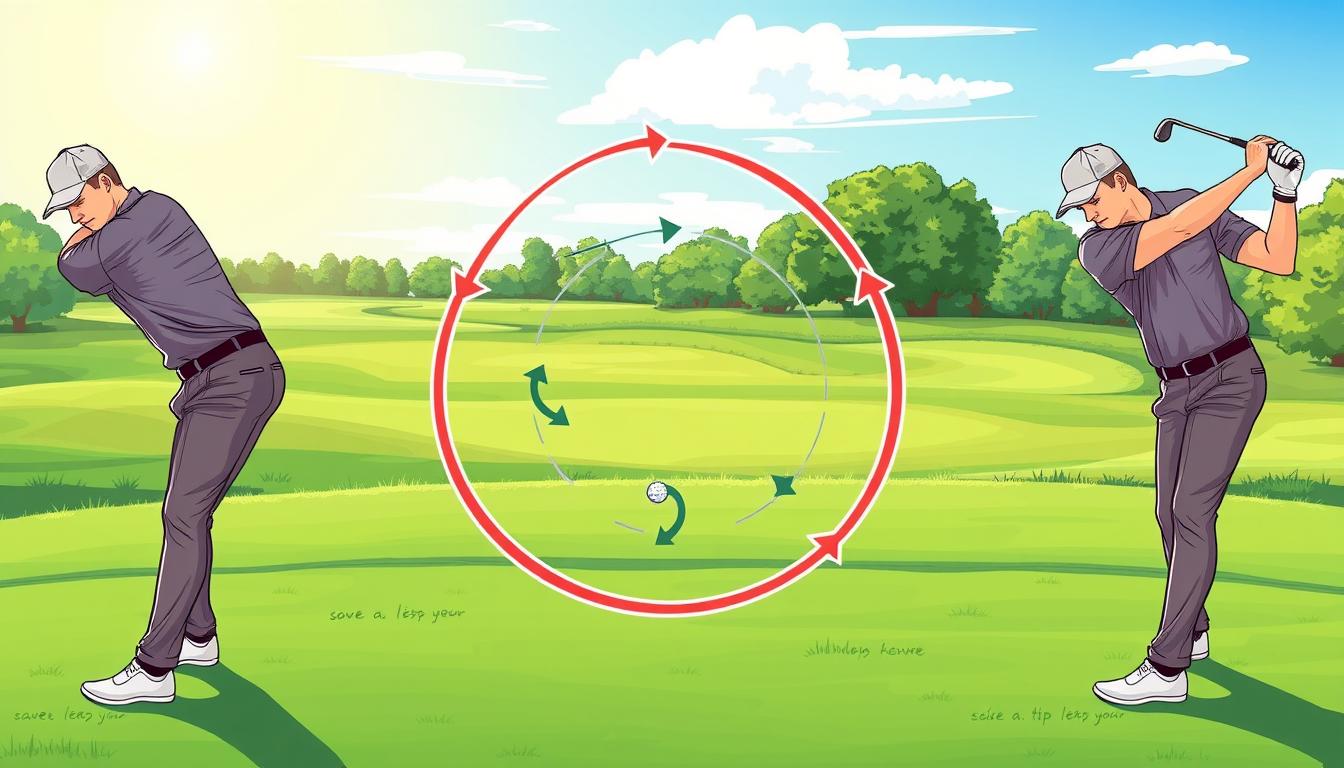Your golf swing mechanics can make or break your game. Body pivot is key in the swing sequence, crucial for power and accuracy. This guide will help you grasp the biomechanics of rotation in golf. It will improve your technique and boost your results on the course.
Proper body rotation is vital for a successful golf swing. It impacts your backswing, downswing, and follow-through. This affects your shot’s power, direction, and control. Mastering rotation will help you hit the ball farther, straighter, and more consistently.
Dr. Mark Bull, a PGA coach, stresses that effective rotation doesn’t need a lot of movement. In fact, the wrists and hands have the biggest role in rotation during the downswing. By focusing on these areas, you can enhance your swing performance.
Key Takeaways
- Body rotation is crucial for power, accuracy, and control in golf
- Proper rotation leads to increased power and better ball flight control
- Wrists and hands have the biggest influence on downswing rotation
- Effective rotation doesn’t require excessive movement
- Understanding biomechanics can help improve your golf swing
Understanding Body Rotation Fundamentals
Golf swing rotation is key to a strong and accurate shot. Learning the basics of body rotation can take your game up a notch. Let’s explore the essential elements for a solid rotational foundation in golf.
The Role of Core Movement
Your core starts the golf swing rotation, being the main source of power. A strong core helps with smoother weight shift and better control of the swing plane. Doing exercises to strengthen your core will boost your rotational power and stability.
Importance of Proper Sequence
The right sequence in golf swing rotation is hips first, then torso, and lastly shoulders. This order creates a coil effect, building up energy for impact. Keeping this sequence helps you hit your shots with more power and accuracy.
Balance and Weight Distribution
Keeping balance and proper weight distribution is key for a stable swing. Begin with your weight evenly split between both feet at the start. As you swing, let your weight move to your back foot during the backswing, then to your front foot at impact.
| Swing Phase | Weight Distribution | Body Position |
|---|---|---|
| Address | 50/50 | Balanced stance |
| Backswing | 70% back foot | Coiled position |
| Impact | 80% front foot | Hips open to target |
| Follow-through | 90% front foot | Balanced finish |
A good golf swing rotation needs core movement, sequencing, and balance. Focus on these basics to improve your swing’s consistency and power. A strong core facilitates proper torso rotation, which is essential for generating power without compromising control. Additionally, learning golf swing alignment tips can help you position your body correctly, ensuring your hips, shoulders, and feet work together harmoniously. By combining these techniques with balanced posture, you’ll achieve greater accuracy and fluidity in your swing.
Common Rotation Problems and Their Solutions
Golf swing issues often come from bad rotation. Let’s look at common problems and how to solve them.
Limited Hip Turn
A small hip turn can take away your swing’s power. To fix this, try an exercise. Stand with your feet shoulder-width apart. Place a club across your hips.
Rotate your hips while keeping your feet steady. Aim for a 45-degree turn. Do this every day to get more flexible.
Restricted Shoulder Movement
A full shoulder turn is crucial for a strong swing. If you’re having trouble, try a drill. Hold a club at chest height with both hands.
Rotate your upper body, keeping your lower body still. Try to turn your shoulders 90 degrees. This helps your upper and lower body move right.
Early Upper Body Rotation
Rotating your upper body too early can cause inconsistent shots. To fix this, use the towel drill. Place a towel under your lead armpit.
Make your backswing while keeping the towel in place. This helps you move your body right and prevents early rotation.
Remember, getting better at golf swing rotation takes time and effort. Focus on these drills to improve your hip rotation, shoulder turn, and swing. With patience and hard work, you’ll see your game get better.
The Connection Between Wrist Action and Body Rotation
Mastering the golf swing is all about how wrist action and body rotation work together. Many golfers find it hard to get this right. This leads to shots that are not consistent and frustration on the course.
Proper Wrist Hinge Timing
The wrist hinge is key in your swing. It keeps the swing plane right and makes the transition smooth. To get the timing right, hinge your wrists slowly during the backswing. This helps in a strong release at impact.
Impact Position Mechanics
At impact, everything must line up perfectly. A square clubface is essential for driver swings. Many golfers try to fix poor wrist rotation by closing the clubface at address. But this can make shots inconsistent.
Instead, aim for a neutral grip to control the clubface better.
Release Point Control
Controlling your release point is crucial for hitting the ball straight and far. The release involves forearm rotation and wrist unhinging. Practice this to avoid pulling shots.
Remember, 85% of golfers don’t know how grip strength affects the ball’s flight.
| Swing Phase | Wrist Action | Body Rotation |
|---|---|---|
| Backswing (First Half) | Minimal hinge | Shoulder turn dominant |
| Backswing (Second Half) | Increased hinge | Independent arm movement |
| Downswing | Unhinging | Core-initiated rotation |
By focusing on these key elements, you’ll get a more connected and powerful swing. Practice often and think about using training aids to improve your technique.
Golf Swing Rotation Guide
Mastering golf swing rotation is key to improving your game. This guide will help you understand the mechanics of a proper swing. It will also boost your performance on the course.
Rotation techniques play a crucial role in generating power and accuracy. A study shows that allowing the club to rotate during the swing can increase club head speed by 7-8 mph. This extra speed translates to greater distance and better control.
Your swing improvement journey starts with understanding the importance of body movement. The golf swing involves a complex relationship between your lumbar spine and hip joints. Professional golfers exhibit a high coupling between these areas, resulting in a smooth, powerful swing.
Here’s a breakdown of key rotation elements in your golf swing:
| Swing Phase | Rotation Focus | Impact on Performance |
|---|---|---|
| Backswing | Full shoulder turn | Generates power for downswing |
| Downswing | Hip rotation initiation | Transfers energy from lower to upper body |
| Impact | Dynamic clubface release | Increases ball flight distance |
| Follow-through | Balanced finish | Reflects overall swing stability |
Remember, proper weight distribution is vital. Aim to maintain 55-60% of your weight on your lead foot for better control. Position the ball slightly forward in your stance to encourage a sweeping motion through impact.
By focusing on these rotation techniques and incorporating them into your golf swing guide, you’ll see significant swing improvement. Practice regularly and pay attention to your body’s movements. This will help you perfect your rotation and elevate your golf game.
Mastering the Backswing Rotation
Getting your backswing rotation right is crucial for a strong and accurate golf swing. Let’s explore the key parts of a great backswing.
Shoulder Turn Mechanics
A good shoulder turn is essential for a solid backswing. Try to turn your shoulders 90 degrees while keeping your lower body steady. This helps build the power for your swing.
Hip Resistance
As your shoulders turn, your hips should stay firm. A 45-degree hip turn with a 90-degree shoulder turn is ideal. This mix of rotations builds energy for your downswing.
Maintaining Spine Angle
Keep your spine angle the same during your backswing. This helps you stay stable and prepares you for a smooth downswing.
| Component | Degree of Rotation | Key Focus |
|---|---|---|
| Shoulder Turn | 90 degrees | Full rotation, maintain stability |
| Hip Turn | 45 degrees | Resist excessive rotation |
| Spine Angle | Maintain initial angle | Consistency throughout swing |
Remember, a well-executed backswing rotation is key to a good downswing and impact. Focus on these elements to boost your golf game and see better results on the course.
Transitioning Through Impact
The golf swing transition is key to a good shot. Moving from backswing to downswing, your body must change smoothly. This change is what sets up your impact position and affects your downswing sequence.
Many golfers find it hard to transition well. A lot start their downswing from the top instead of the ground. This mistake can cause inconsistent shots and less power.

To get better at transitioning, start moving from your lower body. Move your weight to your lead leg and use your core muscles. This makes a strong base for a powerful downswing. Keep your shaft slightly forward at impact for the best ball striking.
Remember, the length of your backswing affects power differently for irons and drivers. With irons, a shorter backswing leads to more consistent hits. For drivers, a longer backswing can add power, but don’t overdo it.
Do drills that focus on weight shift and core rotation. These exercises help your body start the downswing right. Mastering the transition will improve your game’s consistency and power.
Forearm Rotation Techniques
Mastering forearm rotation is key to improving your golf swing release and clubface control. Studies show that proper forearm rotation leads to straighter shots and increased distance. Let’s dive into the techniques that can elevate your game.
Pronation and Supination
In golf, pronation and supination of the forearms play a crucial role. During the backswing, your lead forearm should rotate about 45 degrees in pronation, while the trail forearm rotates 45 degrees in supination. This movement sets up the proper position for a powerful downswing.
Timing the Release
Timing is everything in golf. Rotating your forearms at the right moment is vital to avoid swing errors. The release should occur naturally as you approach impact, allowing for maximum clubhead speed and face control. Practice drills like the Hit it Hard Drill can help perfect your timing.
Face Control Through Impact
Clubface control is directly influenced by forearm rotation. As you strike the ball, your forearms work together to square the clubface. This action, combined with proper body sequencing, ensures consistent ball striking and shot shaping abilities.
Remember, forearm rotation impacts wrist and hand movement, affecting overall control and clubface orientation. By focusing on these techniques, you’ll see improvements in your drive distance and accuracy. Keep practicing, and soon these motions will become second nature in your golf swing.
Power Generation Through Proper Rotation
Proper rotation is key to unlocking golf swing power. Mastering rotation can greatly improve your game. Let’s look at how to use the kinetic chain, speed generation, and ground force to your advantage.
Kinetic Chain Activation
Your body’s power system is the kinetic chain. It connects your feet to your hands. To activate it, start with your legs, then hips, torso, shoulders, and arms.
This smooth motion creates a whip-like effect. It boosts your swing speed.
Speed Generation Methods
To increase speed, create lag in your downswing. Keep your wrists cocked until impact. This stores energy for an explosive release.
Also, maintain width in your backswing by extending your arms fully. This increases your swing arc and club head speed.

Ground Force Utilization
Ground force is crucial for a powerful swing. Push against the ground with your feet during the downswing. This creates a rotational force that travels up your body.
It’s like a sprinter exploding out of the blocks. The more you use ground force, the more power you’ll generate.
Remember, power comes from proper technique, not brute strength. Practice these methods often. You’ll see a big improvement in your golf swing power. Stay patient and consistent for the best results.
Conclusion
Mastering golf swing rotation is a journey of continuous refinement. It’s about understanding the intricate dance of body movements. Each element, from grip to follow-through, is crucial for swing efficiency.
The golf swing is a complex system of interconnected motions. PGA Tour pros can hit the ball at 113 mph in just 0.2 seconds. This speed comes from precise coordination of extension, side bend, and rotation techniques.
To improve your rotation, focus on three key body motions: extension, lateral flexion, and rotation. Proper execution can greatly enhance your ball flight and performance. Many amateurs struggle with overextension or excessive rotation, leading to slices, hooks, or loss of control.
Set specific goals for your swing efficiency. Working with a golf instructor can provide personalized guidance. Use training aids and video analysis to track your progress. With dedicated practice and attention to detail, you’ll achieve a more powerful, consistent, and efficient golf swing.
FAQ
What is the importance of body rotation in golf?
How much should I rotate during my golf swing?
What role do the wrists play in golf swing rotation?
How does core movement affect golf swing rotation?
What are some common rotation problems in the golf swing?
How can I improve my golf swing rotation?
What is the proper sequence for body rotation in the golf swing?
How does forearm rotation affect the golf swing?
What is the kinetic chain in golf swing rotation?
How can I use ground force in my golf swing rotation?
Source Links
- https://hackmotion.com/body-rotation-in-golf-swing/
- https://rotaryswing.com/c4/127-5-minutes-to-master-rotation
- https://golf-upgrades.com/blogs/golf-upgrades-blog/optimizing-your-golf-swing-the-science-of-rotation?srsltid=AfmBOoovWMT-8MNyfZ_XeL_GwTMZlxMHAPyWJ7g-jrNMpAq_OPXrwCdZ
- https://skillest.com/blog/a-comprehensive-guide-to-mastering-the-golf-swing/
- https://swingtrainer.com/blogs/instruction/golf-swing-basics?srsltid=AfmBOorGwZ49vNssxqFx2I8rC7WU9mqGB2gn4mF8tZW4jXjr_NMsjABN
- https://nationalgcla.com/the-basics-of-the-golf-swing/
- https://golf.com/instruction/3-fixable-golf-swing-faults-incorrect-movements/
- https://bodyworkprofessionals.com/golf-and-rotation/
- https://www.performancegolf.com/blog/golf-for-beginners-most-common-mistakes-and-how-to-fix?srsltid=AfmBOorVJyy8bocK6vhsjBGf1-gxGMbRgHqWqHCPme96m3CwolS7Jy3B
- https://forum.practical-golf.com/t/wrist-roll-rotation/2167
- https://teetimespress.com/11/28/2017/2561/hand-action-explained/
- https://newtongolfinstitute.proboards.com/thread/776/swing-follows-principles-human-motion
- https://rotaryswing.com/golf-instruction/club-face-rotation-golf
- https://golf-upgrades.com/blogs/golf-upgrades-blog/optimizing-your-golf-swing-the-science-of-rotation?srsltid=AfmBOooYCEIAU-3It_YCvKDa8DwptIxb2eSOVzLWEpflhVnUnUk8x-f5
- https://golfforbeginners.academy/golf-swing-for-beginners-a-comprehensive-guide/
- https://danfordgolfinstruction.com/perfecting-your-golf-backswing-a-comprehensive-breakdown/
- https://rotaryswing.com/c4/112238-my-golf-backswing-secrets
- https://www.dannymaude.com/blog/Move Your Right Arm Like This For a Perfect Golf Swing
- https://rotaryswing.com/c4/112080-how-to-swing-from-the-ground-up-golf-swing-transition
- https://hackmotion.com/forearm-rotation-in-golf-swing/
- https://devereuxgolf.com/blogs/live-proper-blog/forearm-rotation-golf-swing-basics?srsltid=AfmBOopTDE4TKPy6kqn0APoJ_h8vSsyiBhj3WkTAUJ_lQcz5WmvPaP74
- https://swingproplus.com/blogs/news/the-ultimate-guide-to-improving-your-body-rotation-in-golf-swing?srsltid=AfmBOopoQ3iSvBfy1QejFd_E3szsdH7zmSj7SlAnjZr8E8LDckR-o9Ki
- https://www.trainheroic.com/blog/building-power-and-speed-for-your-golf-swing/
- https://swingfit.net/golf-swing-mechanics/
- https://www.nickadcockgolf.com/new-blog-1/example-post-1-whbgh


